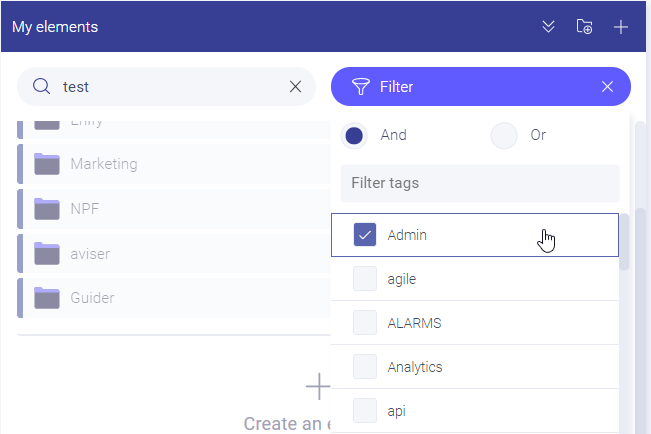Tags in Enify make searching for elements and boards easier. To use tags effectively, follow these best practices.
🏳️Enify 2.0 and above (new version)
How to use tags successfully?
Every user has the ability to create new tags, which are visible to all other users. In order to use them successfully, it is important to follow some ground rules. The purpose of using Enify in operational team workdays is to streamline their processes and reduce complexity. Let's explore how we can effectively implement tags for success.
Practical Applications of Tags:
- Identifying elements and Boards specific to teams or roles in your organization, such as Well 1-3, Field Engineers, Administration, etc.
- For better organization, categorize elements and Boards based on common themes or processes, such as Daily Tasks, Monthly Reports, Programming Guidance, Emergency Response, etc.
- Showing the status of elements and Boards within the system, like In Development, Under Test, Deprecated, etc.

- Establish clear guidelines for tag usage within your group or organization to prevent confusion. Share this information with all users who can create and edit boards, and consider creating a shared board with links to these guidelines for easy access and understanding.
Key Guidelines:
- Use a board or element's name to provide essential information about its purpose, as this is always visible. Consider adding a descriptive word here instead of using a tag.
- Opt to reuse an existing tag if it closely aligns with the new one you intend to create.
- Exercise caution when creating a new tag to ensure correct spelling.
- Evaluate the necessity and usefulness of a new tag before adding it.
- Delete any tags you have generated from the "My profile - Tags" section.
Tip: It is crucial to evaluate the necessity of a new tag. If the tag is only going to be used once or twice, it may not be needed. Additionally, if the new tag's purpose can be inferred from the name, it is unnecessary. A new tag should only be created if it offers something new and beneficial to the majority of users, providing a useful level of organization where it is not already evident.
🏳️Enify old version
How to use tags successfully?
As every user can create new tags to the Workbench and every other user can see them it is very easy for them to proliferate out of control which leads to unnecessary complexity for everyone. And the purpose using Enify in your workday is to remove complexity, so lets have a look at how we can create for success.
How to turn it into success?
- Good Uses for Tags:
- Identification of elements and Boards relevant to particular Teams or Roles within your organisation: Finance, HR, Field Engineer, Administration, Finance, etc
- Assigning elements and Boards to an overall interest, category or process to group them together for users: Daily Tasks, Monthly report, Programming Guidance, Emergency Response, Games Rulebooks, Surveillance Work, Online Meeting, etc.
- Indicate the maturity of the elements and Boards in the system: In Development, Under Test, Deprecated, etc.

- We recommend that you:
- Create a broad "terms of use" for tags within your group or organization before they get out of hand.
- Make sure you propagate this information to anyone who can create and edit boards and ensure they understand it;
- Create a shared board with links to this information so it is always on hand and easily digested.
General RULES OF THUMB:
- The name of a board or element is the best place for critical information for its purpose as this can be seen all the time. Adding a word there may be more helpful than a tag.
- Always re-use an existing tag if it is "close enough"
- Be very careful when adding new tag that you have spelt it right
- Ask yourself if you really need a new tag... is it useful?
- You can delete tags you have created from My profile - Tags
Tip: This latter point is the most important; If the tag is likely to only be used once or twice then it is probably not needed. If the new tag can be inferred from the name it is not needed. A new tag in only needed if it is bringing something new and beneficial to the majority of users and provides a useful level of extra level of organisation where it is not otherwise obvious.
